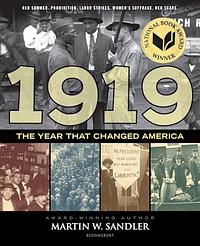You need to sign in or sign up before continuing.
Take a photo of a barcode or cover
I absolutely hated the formatting. It only added to the clunkiness of what was already a bit hard to get into. It didn't read as a story of 1919. It was more of an anthology of stories they tried to connect faintly on the last page of the book.
There was good and interesting information throughout, but on the whole it was sub-par as YA nonfiction.
There was good and interesting information throughout, but on the whole it was sub-par as YA nonfiction.
With a lot of interesting information in here, this book serves as a primer on many of the major changes and happenings in the US in the years between the world wars. It is divided into 6 chapters, each covering a theme: fear of Communism, Labor movement, racism/lynchings, women's suffrage, Prohibition, and....the Great Molasses Flood. A little known event in history outside of the Boston area, the Great Molasses Flood was tragic and awful and brought about reforms to industry standards, but Sandler didn't really convince me that this was on the same scale as, say, the 19th Amendment. Because the Molasses Flood is the first chapter of the book, I expected the players or the results to resonate through the other chapters in some kind of symbolic way, but they didn't. Instead, each chapter seemed to stand on its own. Only the Red Scare really seemed to be deliberately connected to another chapter. There were additional “sidebars” to give further information, and I found these distracting and not effective. These sidebars were consistently presented as a full two-page spread in the middle of the chapter, usually breaking up sentences of the basic content and interrupting the narrative. Sometimes they were background, like “Molasses”, and sometimes they were completely unrelated to the core chapter, such as “The Black Sox Scandal”. Another feature that seemed shoe-horned in was the “One Hundred Years Later” commentary at the end of most (but not all) chapters. Sometimes it really felt valid and meaningful to bring the content forward through the last century. But sometimes, it felt too forced and slanted toward a particular viewpoint. I think in those cases it may actually hurt his cause rather than furthering it.
Would I have been this harsh on the book if I had read it back in September? Definitely not. But this won the *National Book Award* for young people's literature, and I needed to see how this was the best book of the year. It was good, but I truly don't see how a committee considered this better than many of the other excellent books published in 2019.
Would I have been this harsh on the book if I had read it back in September? Definitely not. But this won the *National Book Award* for young people's literature, and I needed to see how this was the best book of the year. It was good, but I truly don't see how a committee considered this better than many of the other excellent books published in 2019.
Can see why this was nominated for the YA NBA, but very surprised it won over the others (Pet was my pick). I did learn about some historical events I wasn't familiar with - the molasses flood - and gained some more details on others like Red Summer. I liked the that each chapter had a look how a particular chapter's events still reverberate 100 years later. I liked the theory of selective timelines by theme for each chapter, but in practice it felt too limiting. I was surprised that there weren't footnotes used, but there is an index and works consulted. I'm not sure what kid I'd get take read this or use for research, as it's cut to such a large format. I do think it's valuable, so we'll see if I can get it to gain any traction with my students and teachers.
Coincidence or not when my library closes down for the pandemic at hand this is one of two books I had checked out and get to keep for the indefinite time ahead. I finally decided to read it. It was quite interesting how similar times were back then. Some of the exact same issues are still at hand. Today it is coronavirus instead of flu. Today it is gun violence or marijuana instead of alcohol. We still have organized crime. We still are having labor disputes. We still question what exactly the Russians are doing in our society. We still haven’t elected a woman President (or even as Vice). History does indeed repeat. But there has been progress too. Though maybe not as much as I would have thought. I found it a very interesting read, especially now.
I first want to say that I did not realize this is categorized as a "children's book." I saw it on a library shelf and thought I'd like to read about the year my father was born. (It was right around the time of my late father's 100th birthday.) So, I found myself reading this fascinating history book, thinking to myself that is was the most cogently written history book I'd ever read, and how much the old photos added to the experience. I remember thinking to myself that it was formatted like those dreary history books written for children -- the ones they hate to read -- but this was so much more interesting! I (an educated person with two graduate degrees) was learning interesting relevant things!
Then I discovered it IS a child's history book. Imagine my chagrin. Well. I felt a little silly.
But no matter, because this really IS an interesting book for a non-historian-though-educated adult. I learned plenty of things that rounded out my knowledge of the Women's Suffrage Movement (what a jerk Woodrow Wilson was!), labor unions, the first Red Scare, and prohibition. I even learned about the Great Molasses Flood, which I had absolutely never heard of.
So, I encourage adults who are curious to read this book. It's interesting, it has a contemporary interpretation, and the photos are awesome! Do read it, because I doubt many kids will.
Then I discovered it IS a child's history book. Imagine my chagrin. Well. I felt a little silly.
But no matter, because this really IS an interesting book for a non-historian-though-educated adult. I learned plenty of things that rounded out my knowledge of the Women's Suffrage Movement (what a jerk Woodrow Wilson was!), labor unions, the first Red Scare, and prohibition. I even learned about the Great Molasses Flood, which I had absolutely never heard of.
So, I encourage adults who are curious to read this book. It's interesting, it has a contemporary interpretation, and the photos are awesome! Do read it, because I doubt many kids will.
I had never heard of the Great Molasses Flood! This book was so insightful and just the right amount of information to comprehend.
So interesting. I loved the connections to present day. I think adults would enjoy this one, too
What an amazing year 1919 was. It is a year full of change in America and not all of it is known is known to Americans. 1919 was the year after the Great War (WWI) and the Spanish Flu epidemic and it was a busy year. The Great Molasses Flood destroys part of Boston's North End. I had heard of the molasses flood (thanks I Survived series), but didn't realize it was all about liquor! Prohibition is coming later in the year and molasses is a main ingredient in rum. The disaster was also one of the first times a company was held liable for damages to people and property. Then came the suffragettes and the right to vote for women. What always surprises me about this issue is how the West was more progressive and allowed women more power than the East. That and how long it actually took for women to get the vote. There is a still a long way to go towards true equality but it was a big start. Then you have Prohibition, the biggest failed experiment in American politics. It is interesting to me that making alcohol illegal brought about so many bad things, like gangsters. It didn't even solve the problem it was supposed to but instead created new ones. The other things touched on in this book are race riots and strikes. While the strikes were largely unsuccessful they did help future generations and were instrumental in starting talks on how workers should be treated. Then there were the race riots which I think are largely unknown and untaught in American history. We think of racial tensions in the 1960s but 1919 was a year where a lot of blood was spilled because of race. I really enjoyed how all these events were tied together by Sandler to create a picture of what was going on in this country during this pivotal year 100 years ago. However, my favorite parts of the book were the looking forward sections after each event that tied that event into current events. Some have direct correlations but others were a little more subtle and really made you think.
I am not what you would call a history buff or a fan of non-fiction, but this was a truly amazing book! I did not know that so many life changing events happened in 1919. I do find it interesting that our society hasn't learned much from past experiences, and we are still dealing with some of the same situations 100 years later (discrimination, governmental corruption, pay inequality...). I think this should be a textbook for upper elementary or middle school curriculum. I hope to order it for my library.
I couldn’t get into this at all, but since I barely skimmed it after the first page, I won’t give it a rating.


